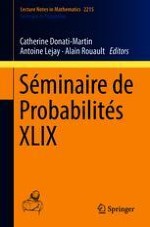Abstract
The iterative proportional fitting procedure (IPFP), introduced in 1937 by Kruithof, aims to adjust the elements of an array to satisfy specified row and column sums. Thus, given a rectangular non-negative matrix X
0 and two positive marginals a and b, the algorithm generates a sequence of matrices (X
n)n≥0 starting at X
0, supposed to converge to a biproportional fitting, that is, to a matrix Y whose marginals are a and b and of the form Y = D
1X
0D
2, for some diagonal matrices D
1 and D
2 with positive diagonal entries.
When a biproportional fitting does exist, it is unique and the sequence (X
n)n≥0 converges to it at an at least geometric rate. More generally, when there exists some matrix with marginal a and b and with support included in the support of X
0, the sequence (X
n)n≥0 converges to the unique matrix whose marginals are a and b and which can be written as a limit of matrices of the form D
1X
0D
2.
In the opposite case (when there exists no matrix with marginals a and b whose support is included in the support of X
0), the sequence (X
n)n≥0 diverges but both subsequences (X
2n)n≥0 and (X
2n+1)n≥0 converge.
In the present paper, we use a new method to prove again these results and determine the two limit-points in the case of divergence. Our proof relies on a new convergence theorem for backward infinite products ⋯M
2M
1 of stochastic matrices M
n, with diagonal entries M
n(i, i) bounded away from 0 and with bounded ratios M
n(j, i)∕M
n(i, j). This theorem generalizes Lorenz’ stabilization theorem. We also provide an alternative proof of Touric and Nedić’s theorem on backward infinite products of doubly-stochastic matrices, with diagonal entries bounded away from 0. In both situations, we improve slightly the conclusion, since we establish not only the convergence of the sequence (M
n⋯M
1)n≥0, but also its finite variation.
